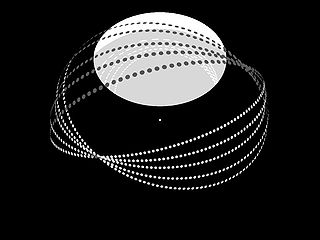
A Dyson sphere is a hypothetical megastructure that completely encompasses a star and captures a large percentage of its solar power output. The concept is a thought experiment that attempts to explain how a spacefaring civilization would meet its energy requirements once those requirements exceed what can be generated from the home planet's resources alone. Because only a tiny fraction of a star's energy emissions reaches the surface of any orbiting planet, building structures encircling a star would enable a civilization to harvest far more energy.
Halo, halos or haloes usually refer to:
A matrioshka brain is a hypothetical megastructure of immense computational capacity powered by a Dyson sphere. It was proposed in 1997 by Robert J. Bradbury (1956–2011). It is an example of a class-B stellar engine, employing the entire energy output of a star to drive computer systems. This concept derives its name from the nesting Russian matryoshka dolls. The concept was deployed by Bradbury in the anthology Year Million: Science at the Far Edge of Knowledge.

Blame! is a Japanese science fiction manga series written and illustrated by Tsutomu Nihei. It was published by Kodansha in the seinen manga magazine Monthly Afternoon from 1997 to 2003, with its chapters collected in ten tankōbon volumes. A six-part original net animation was produced in 2003, with a seventh episode included on the DVD release. An anime film adaptation by Polygon Pictures was released as a Netflix original in May 2017.

A megastructure is a very large artificial object, although the limits of precisely how large vary considerably. Some apply the term to any especially large or tall building. Some sources define a megastructure as an enormous self-supporting artificial construct. The products of megascale engineering or astroengineering are megastructures. The lower bound of megastructural engineering might be considered any structure that has any single dimension 1 megameter (1000 km) in length.
Megascale engineering is a form of exploratory engineering concerned with the construction of structures on an enormous scale. Typically these structures are at least 1,000 km (620 mi) in length—in other words, at least one megameter, hence the name. Such large-scale structures are termed megastructures.

Ecumenopolis is the hypothetical concept of a planetwide city.

Stellar engines are a class of hypothetical megastructures used to control the motion of a star system. The concept has been introduced by Badescu and Cathcart. Some variants use this energy to produce thrust, and thus accelerate a star and anything orbiting it in a given direction. The creation of such a system would make its builders a type-II civilization on the Kardashev scale.

Megastructures is a documentary television series appearing on the National Geographic Channel in the United States and the United Kingdom, Channel 5 in the United Kingdom, France 5 in France, and 7mate in Australia.
Megastructure is an architectural and urban concept of the post-war era, which envisions a city or an urban form that could be encased in a massive single man-made structure or a relatively small number of interconnected structures. In a megastructural project, orders and hierarchies are created with large and permanent structures supporting small and transitional ones.
Large-scale structure may refer to:
A superstructure is an upward extension of an existing structure above a baseline, in civil and naval engineering.
Engineering on an astronomical scale, or astronomical engineering, i.e., engineering involving operations with whole astronomical objects, is a known theme in science fiction, as well as a matter of recent scientific research and exploratory engineering.

The Halo Array is a group of fictional megastructures and superweapons in the Halo science-fiction franchise, consisting of ringworlds known as Halos built by a structure known as the Ark. They are referred to as "Installations" by their artificial intelligence caretakers, and were created by an ancient race known as the Forerunners. The series' alien antagonists, the Covenant, refer to the Halos as the "Sacred Rings", believing them to form part of a greater religious prophecy known as "The Great Journey". In the games' stories, the Forerunners built the Halo Array to contain and study the Flood, an infectious alien parasite. The rings act together as a weapon of last resort; when fired, they kill all sentient life in the galaxy capable of falling prey to the Flood, thereby starving the parasite of its food. The battle to prevent their activation forms the crux of the plot progression for the first Halo trilogy of games.

Tabby's Star is an F-type main-sequence star in the constellation Cygnus approximately 1,470 light-years from Earth. Unusual light fluctuations of the star, including up to a 22% dimming in brightness, were discovered by citizen scientists as part of the Planet Hunters project. In September 2015, astronomers and citizen scientists associated with the project posted a preprint of an article describing the data and possible interpretations. The discovery was made from data collected by the Kepler space telescope, which observed changes in the brightness of distant stars to detect exoplanets.
Nazi Megastructures is a documentary television series appearing on the National Geographic Channel and a spinoff of the broader Megastructures television series. The series also aired as Nazi Mega Weapons on PBS, and as WWII Mega Weapons.

The Citadel is a fictional space station and megastructure in the Mass Effect franchise of video games developed by BioWare. An ancient station supposedly constructed by the long-dead Protheans, it serves as the hub of interstellar politics and society in the Milky Way galaxy due to its status as the capital of the Citadel Council, the dominant galactic polity within the Mass Effect universe. The Citadel was praised by critics for its design, lore, and the diversity of its inhabitants enhancing the game world.
This page is based on this
Wikipedia article Text is available under the
CC BY-SA 4.0 license; additional terms may apply.
Images, videos and audio are available under their respective licenses.








